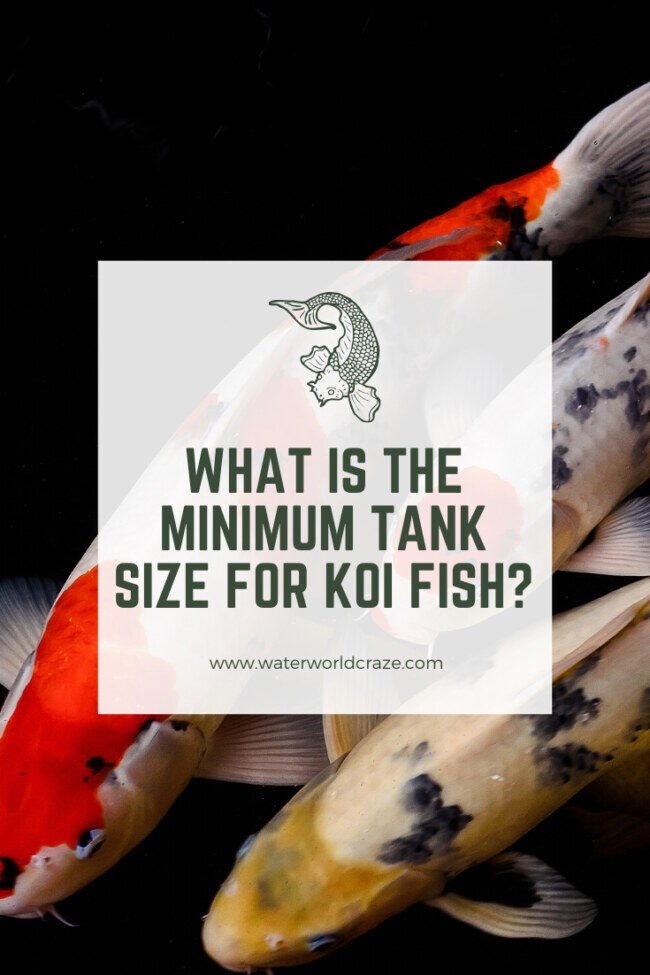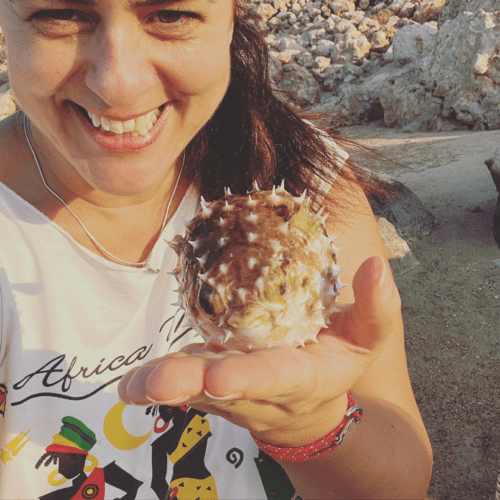 Traditionally koi live in an outdoor pond environment, but with a little thought and preparation koi can live indoors.
Traditionally koi live in an outdoor pond environment, but with a little thought and preparation koi can live indoors.
Koi fish minimum tank size? The minimum size requirements for koi differ between indoor tank set up and an outdoor pond. These size requirements reflect the size of koi that are kept in each containment.
However, each type has different measurements to go by. For an indoor tank, your koi will need at least a 50-gallon aquarium. Ponds, on the other hand, have to be bigger, the recommended size for a koi pond is 250 gallons for one fish.
Which type you choose depends on your situation. Read further for the size needed for each type and the advantages and disadvantages.
Table of Contents
Space requirements for koi
While we think of koi living in a pond they are a very versatile fish when it comes to indoor or an outdoor environment. Each one, however, has its requirements when it comes to size.
Size of koi
In addition to the variety of colors that koi exhibit they also come in a variety of sizes. To determine the size of the tank that you need first the size of your koi needs to be established.
Koi come in many sizes, the standard three are:
- Koi: 12-15 inches long
- Japanese Koi: 22-26 inches long
- Jumbo Koi: 34-36 inches long
Even the smaller variety of koi grow pretty long for a domesticated fish. Koi will grow to their genetic length regardless of the size of the tank that they are in. Being held in a smaller tank will just slow down the time it takes for your koi to reach their full length.
Here are a few articles we also recommend reading before choosing a tank for you koi fish:

Size of a tank for smaller fish
The minimum aquarium size for the smaller koi is 50 gallons with a general measurement of 36 7/8 x 19 x 19 5/8. Just for one fish. For each additional fish add another 50 gallons.
So if you have six koi fish you will need a 300-gallon tank. As you can see the 50-gallon aquarium is only for the smaller koi allowing them over half of the space to swim around in. Your koi should be of the same length as their environment.
While koi fish can live in a tank alone it isn’t their natural way of doing things. The koi is a not a specific breed of fish, but a variety of the Amur carp that are selectively bred for their color.
Amur carp are a shoaling fish meaning they swim together loosely. Whereas schooling fish swim in the same direction. A shoaling fish will deal with being alone better than a schooling fish, but they still would rather be with those of their species.
Consequently, if you want your koi to have a satisfying life plan on purchasing a group of them, typically enthusiasts will purchase koi in odd numbers. A tradition that harks back to its Japanese roots.
When the Japanese and Jumbo koi are young it is ok to keep them in an indoor tank, this an effective way to keep them away from predators. However, as they start to grow they will need much larger accommodations either indoor or outdoor.
Smaller koi of the 15-inch variety can live indoors easily due to their size.
For a community tank compare the size requirements for each of the fish to prevent any territorial action. Not an impossible task, but it does require some thoughtfulness on your end and enough room in your home.
Koi are naturally a very docile fish, but if they don’t have enough room they will pick on those that are smaller than them.
Pond size or large koi tanks
Those that are planning a pond for their koi the measurements are a bit higher. Traditionally koi ponds have larger types of koi fish such as the Japanese or Jumbo fish.
A good rule of thumb to go by for ponds or larger koi tanks is 250-gallons per koi fish. A koi pond with 5 fish will need to be 1250-gallons and at least 3-feet deep.
The depth of the pond needs to increase to 5-feet deep if you live in a colder environment to prevent the pond from freezing over.
That might seem like an exaggeration, but these are large fish and they need their room. With too many fish in the pond, a lot of waste will build up making them miserable and unable to breathe.
Adding a hardcore filtration system and various additions like a waterfall or air stones for air circulation help with the toxins your fish will inevitably produce. Though it won’t work miracles for an overstocked pond.
Keep on a conservative estimate for your koi fish and they will be a happy and healthy addition to your family for a long time.
As for depth, it might not seem like it, but koi are a bottom-dwelling fish. The only reason we misconstrue them as a surface level fish on account of their appetite compelling them to the surface for snacks from you.
Pond vs. Tank
Whether you should build a pond or set up an aquarium indoors is entirely up to you, your situation, and what you can afford. Each option has its’s advantages and disadvantages.
Larger aquariums or even pond setups are difficult to find online. For the main components of your koi’s environment, you will have to go to a specialty retailer if you plan on having multiple koi.
Tanks
When you think of koi you usually picture them in a pond coming up to great whoever is feeding them. While that does sound idyllic not everyone has the means of making a koi pond happen.
Koi are not exclusive to those who have outdoor access such as people who live in apartments or those who rent and are not able to dig.
When your koi are indoors you can control the temperature of the water a lot more than you do in an outdoor pond. This simple action makes feeding your koi a whole lot easier.
The koi’s appetite is determined by the season. In the summer, their metabolism is a lot higher, while in the wintertime it can be completely non-existent. With the ability to control the temperature of their environment keeping up with this feeding schedule is erased.
The average temperature range for an indoor koi tank is from 68° to 77° F keeping your koi in the light summer feeding phase of 3 to 4 times daily.
They still need to have small meals throughout the day due to their lack of a stomach, with each feeding lasting 5 minutes. Since they will be fed plenty of times throughout the day treats are still an option.
Another advantage of using an indoor tank is protection. Outdoors your koi are exposed to the various predators that might come along such as raccoons or large birds of prey.
You also don’t have to worry about the dreaded algae bloom season when your pond will turn pea green.
Tanks larger than 55-gallons can be purchased from specialty retailers. Younger large koi can live together in a smaller tank if are small. This will be a temporary situation until they start to grow in length.
The time that it takes them to grow can be used towards putting the final changes on your koi’s permanent home.
Ponds
The classic set up. Koi just love to be in a pond. It provides them with ample room and plenty of snacks when you aren’t around. Honestly, it is just visually stimulating to walk out to your koi pond and see their little heads bobbing up and down ready for food.
Larger koi ponds also provide you with room for your family of fish to grow. People who own koi start to get an addiction to them and they want increasingly.
Are outdoor ponds harder to maintain? Yeah, they are. Is it worth it to give your koi a large place to not only live but thrive in as close as you can get natural environment while also appreciating the beauty of it all? Yes, it is.
For outdoor ponds you have two options, hire a professional or set it up yourself. Using a professional will help guarantee your pond is set up correctly, but it will cost you quite a few coins.
Whereas building a koi pond yourself is a lot cheaper and gives you a closer understanding of your pond set up. Either way, you are going to pay either with your wallet or your back.
Setting up an outdoor pond is an intensive process looking out for electrical wires, placement, and obtaining the right equipment for your level of involvement. Research your land to prevent cutting any wire’s or busting into a septic tank before building.
If your ultimate plan is to have a koi pond in your bank yard start your research before purchasing your fish.
Whatever you choose for your koi make sure it is comfortable for both you and your fish. Koi are large fish by domesticated standards and need the room to accommodate them.
If you are not in a situation right now to fulfill those needs just wait a bit before you start raising koi.

Marta, the driving force behind WaterWorldCraze.com, holds a Master’s degree in Marine Biology and has extensive experience in water sports and activities. With over 7+ years of hands-on experience in marine research and conservation, she has participated in numerous underwater expeditions and projects. Her passion for the aquatic world shines through in her expertly curated content. Join Marta as she explores the wonders of marine life and shares her adventures. Connect with her on Instagram @marinebiologymarta for more insights and updates.
